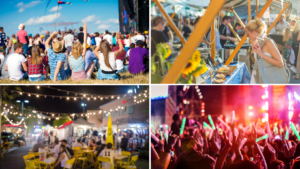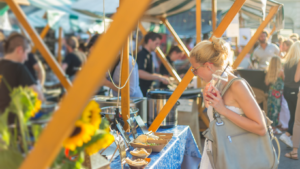In the bustling world of events, planning for local festivals is a vibrant and rewarding endeavor. Each festival, whether a fall festival with its autumnal charm, a food festival offering a smorgasbord of flavors, or a music festival creating unforgettable memories, is a unique special event that brings people together. For an event planner, navigating the complexities of festival planning is crucial for resonating with attendees.
Festival planning involves more than just basic organization; it encompasses managing food vendors, coordinating with artists for music festivals, and ensuring each event reflects its unique theme and audience. This requires keen attention to detail, from securing permits to managing ticket sales and event registration. Effective communication with stakeholders, including local businesses and public works, is key to aligning every festival aspect with the overall vision.
A successful festival planner also focuses on creating an engaging atmosphere, incorporating interactive elements like workshops and parades to enhance attendee enjoyment. In today’s digital age, leveraging tools like the Hobnob app can streamline various aspects of festival planning, enhancing both logistics and the attendee experience.

Embracing Digital Innovation with Hobnob in Festival Planning


In the contemporary digital era, the landscape of event planning has been fundamentally transformed by innovative tools, with Hobnob leading the charge. This versatile digital invitation app has redefined the dynamics of organizing events, from corporate events to community festivals, and even intimate gatherings like birthday parties. Its multifaceted capabilities not only streamline the planning process but also significantly enhance the interaction and experience of both organizers and attendees.
Hobnob’s platform stands as a paradigm of digital efficiency in event management. It offers an integrated solution for a range of essential tasks: from facilitating seamless communication with guests — a critical aspect in the successful execution of any event, to the collection of RSVPs, which is pivotal in managing event logistics, particularly in events like music festivals or food festivals where attendee count directly influences various aspects like venue capacity and catering needs.
Moreover, the app’s photo management feature adds a layer of engagement, allowing organizers and attendees to share and curate memories from the event. This not only enriches the attendee experience but also provides valuable content for promoting future events. In addition, Hobnob’s capability to send instant text updates is invaluable, particularly for large-scale and dynamic events like outdoor festivals, where real-time communication regarding schedule changes, venue adjustments, or emergency announcements is essential for maintaining a smooth and safe event flow.
Furthermore, Hobnob excels in facilitating group organization. This feature is particularly beneficial for event planners and organizers in managing various groups involved in an event, such as event staff, vendors, and volunteers. For instance, in a community event or a corporate event, where coordination among different teams is crucial, Hobnob’s group management tools ensure efficient and streamlined communication.
The ease of use and comprehensive features of Hobnob also empower event planners to devote more attention to the finer details of festival planning, like curating thematic elements for a special event, liaising with food vendors and artists for a music festival, or arranging decorations and entertainment for a birthday party. The app essentially acts as a digital assistant, enabling a more focused and creative approach to creating memorable events.
Embracing Community and Local Businesses
Community festivals stand as vibrant celebrations of unity and local culture, showcasing the spirit of togetherness that binds neighborhoods and cities. These events not only serve as social gatherings but also offer a vital platform for local businesses to display their products and services, thus playing a significant role in the local economy. By integrating these businesses into the fabric of the festival, organizers can contribute positively to the festival budget and enhance the overall experience for attendees.
Local businesses, ranging from artisan craft shops to homegrown eateries, bring a unique and authentic flavor to these events. Their participation reflects the community’s identity and fosters a sense of pride among residents. For example, in a food festival, local food vendors become the heart of the celebration, offering a diverse array of cuisines that cater to the varied tastes of the festival’s target audience. This not only provides exposure for these small businesses but also satisfies the culinary curiosity of attendees.
Moreover, local restaurants play a pivotal role in these community events. By setting up stalls or offering special festival menus, they contribute to the vibrant atmosphere of the event, adding a familiar and comforting flavor that resonates with the local populace. Their involvement also encourages a sense of community support and patronage, which is essential for the growth and sustainability of local businesses.
In addition to food vendors, other local businesses such as craft stores, entertainment services, and local artisans can contribute to the festival’s diversity. Their unique products and services add depth to the festival experience, offering attendees more than just a day out but an opportunity to explore and support the local economy.
For event organizers, collaborating with these local entities is crucial. It involves careful planning and coordination to ensure that the needs of the businesses are met while aligning with the overall theme and objectives of the festival. This partnership not only benefits the businesses by providing them with a platform to showcase their offerings but also enriches the festival itself, making it a more holistic and engaging experience for attendees.
Embracing community and local businesses in festival planning is about creating a symbiotic relationship where the festival thrives on the contributions of local entities, and in return, provides them with a stage to flourish and connect with a wider audience. This approach not only elevates the festival’s appeal but also strengthens the local economy, fostering a sense of communal success and pride.
In summary, the integration of local businesses into community festivals is a key element in creating a successful and memorable event. It celebrates the uniqueness of the community, supports local entrepreneurship, and enhances the overall festival experience, creating a win-win situation for both the organizers and the local business community.

Embracing Community and Local Businesses in Festival Planning
In the contemporary digital era, the landscape of event planning has been fundamentally transformed by innovative tools, with Hobnob leading the charge. This versatile digital invitation app has redefined the dynamics of organizing events, from corporate events to community festivals, and even intimate gatherings like birthday parties. Its multifaceted capabilities not only streamline the planning process but also significantly enhance the interaction and experience of both organizers and attendees.
Hobnob’s platform stands as a paradigm of digital efficiency in event management. It offers an integrated solution for a range of essential tasks: from facilitating seamless communication with guests — a critical aspect in the successful execution of any event, to the collection of RSVPs, which is pivotal in managing event logistics, particularly in events like music festivals or food festivals where attendee count directly influences various aspects like venue capacity and catering needs.
Moreover, the app’s photo management feature adds a layer of engagement, allowing organizers and attendees to share and curate memories from the event. This not only enriches the attendee experience but also provides valuable content for promoting future events. In addition, Hobnob’s capability to send instant text updates is invaluable, particularly for large-scale and dynamic events like outdoor festivals, where real-time communication regarding schedule changes, venue adjustments, or emergency announcements is essential for maintaining a smooth and safe event flow.
Furthermore, Hobnob excels in facilitating group organization. This feature is particularly beneficial for event planners and organizers in managing various groups involved in an event, such as event staff, vendors, and volunteers. For instance, in a community event or a corporate event, where coordination among different teams is crucial, Hobnob’s group management tools ensure efficient and streamlined communication.
The ease of use and comprehensive features of Hobnob also empower event planners to devote more attention to the finer details of festival planning, like curating thematic elements for a special event, liaising with food vendors and artists for a music festival, or arranging decorations and entertainment for a birthday party. The app essentially acts as a digital assistant, enabling a more focused and creative approach to creating memorable events.
Managing Logistics: Ticket Sales, Vendor Coordination, and Event Staff
Effective management of ticket sales is key to the success of any festival. Whether it’s an outdoor festival, a beer festival, or a music festival, ensuring smooth event registration and ticketing is essential. This not only aids in crowd control but also helps in estimating the number of festival attendees, which is crucial for planning logistics.
Coordinating with vendors is another critical aspect. From food vendors to those selling artisanal goods, each vendor adds value to your festival. It’s important to understand their needs and ensure they align with the overall theme and quality of the event.
The event staff, from security to volunteer coordinators, play a vital role in the success of the festival. They ensure the planning process translates into a successful event, managing aspects like crowd control, public works, and ensuring the safety and comfort of guests.
Marketing and Promotion: Reaching Your Audience
The success of a festival hinges on attracting the right audience, making event promotion crucial. Utilizing a blend of social media, local press, and digital platforms like Hobnob is essential in spreading the word about your upcoming festival.
Social media platforms such as Facebook, Instagram, and Twitter are invaluable for reaching a broad audience. They enable organizers to engage with potential attendees through compelling content, updates, and interactive posts. Influencer partnerships can also help amplify your festival’s reach.
Local press, including newspapers and local TV stations, are particularly effective for community festivals. They cater to a local audience who may be more inclined to attend nearby events. Engaging these outlets with press releases or interviews can significantly boost local interest.
Digital platforms like Hobnob offer innovative ways to manage invitations and keep attendees engaged and informed. Creating an event page on Hobnob can serve as a central information hub, encouraging RSVPs and providing regular updates to keep the festival in the minds of potential attendees.
Tailoring your marketing strategy to your target audience is key to increasing relevance and effectiveness. Understanding the demographics and interests of your audience allows for more personalized marketing efforts. Early bird tickets or special discounts can incentivize ticket sales, while collaborations with local businesses or sponsors can expand reach and add value for the audience.
The Art of Creating a Successful Festival
Creating a successful festival, whether it’s a corporate event, a vibrant local festival, or an event worthy of international journal, hinges on meticulous planning and execution. The process involves several crucial steps, each contributing significantly to the event’s success.
Setting a realistic festival budget is the foundation of good planning. It encompasses all financial aspects, from venue costs to entertainment and marketing expenses. This ensures that every element of the festival is financially sound and sustainable.
Community engagement is vital in festival planning. Involving local businesses and incorporating their unique offerings enriches the festival’s appeal. This engagement can range from featuring local artisans and performers to integrating local culture into the festival’s theme.
Planning for various types of festivals, each with its unique requirements, is key. For instance, music festivals need careful planning around acoustics and artist lineups, while food festivals focus on vendor selection and cuisine variety. If the event includes a parade, route planning and safety measures become essential.
Throughout the planning process, prioritizing the attendees’ experience is crucial. This means creating a festival environment that is not only entertaining but also safe and welcoming for all. A successful festival leaves attendees with memorable experiences and a desire to return, striking a balance between practical logistics and creative flair.
Conclusion: The Journey of Event Planning
Planning for local festivals is an intricate journey that combines community elements into memorable experiences. Tools like Hobnob streamline this process, allowing event planners, whether seasoned or new, to focus on creating special events that resonate with guests.
From orchestrating a fall festival to managing a food festival or a music festival, each event requires careful planning and collaboration. These events, ranging from community festivals to corporate events, involve various components such as managing ticket sales for an outdoor festival or coordinating food vendors for a successful food festival.
Event planning also involves engaging local businesses and restaurants, enhancing authenticity and supporting the local economy. Effective event registration and ticket sales are crucial, especially for events like music festivals, where crowd control is essential for attendee safety.
Incorporating volunteers into event staff, alongside professional event organizers, ensures smooth operation, from public works to guest experiences. Setting a realistic festival budget, engaging with event producers, and understanding the target audience are key to a successful festival.
Successful event planning is about more than logistics; it’s about creating a shared space for memorable experiences, whether it’s a local festival, a parade, or a larger corporate event. The goal is to build festivals that leave lasting impressions and encourage attendees to return, highlighting the importance of detailed planning, collaboration, and passion in crafting unforgettable community events.






















